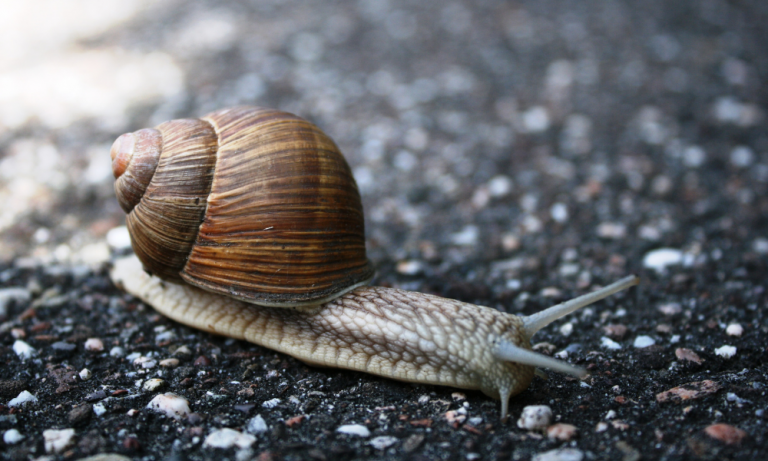SLOW AS SNAIL
The path to the beach is gravelly limestone and someone has placed two by fours sideways to hold the ground in a sort of terraced steps. Bright yellow and orange Indian paintbrush flowers line the path with a chaos of color and there is one volunteer papaya with infant fruit and a mass of sea grapes with their big shiny fig-like leaves. They are just beginning to set fruit too. I love to suck their sun-warmed sweetness when they ripen in the breathtaking heat of a subtropical July.
At the crest of the hill, the turquoise Atlantic comes into view. I never tire of this sight and often break into a run in my eagerness to reach that remarkable water which, thanks to Jimmy Buffett, I always think of as Mother Ocean. But, at the edge of the landscape, where the sea grapes and scrub stop, my feet become the focus of the journey. Or, rather, what’s under them does. Here, the limestone becomes what we call cheese-grater rock.
Did you ever make drip castles at the beach? My mother taught me how to hold the drippy sand in one hand and let it run down my index finger to build up pointy castle peaks. This is what the cheese grater rock resembles, although it was not built up, but rather eroded by the constant action of water. It is beautiful, dark, and holey, and extremely treacherous to walk on. But that is not the only reason I slow my feet. Above the high tide line, where it’s safe to walk without fear of being dashed by a wave, cut to ribbons on the rocks, and ending up as a shark feast, the rocks are strewn with thousands of the cutest tiny unmoving snails.
I use my new Google Lens app to find out their name. It’s a long one: Echinolittorina. There are over sixty species of them, all with tongue-twisting surnames. But the common name is adorable: Periwinkles or Winkles for short. They have been a staple food for humans for thousands of years. In Scotland, you can buy a brown bag of them, boiled in their native sea water, with a pin attached to the bag so you can dig out the delicious critter and slurp it down. Move over escargot.
Some of the snails on this beach are white and on the large side, still less than an inch from base to tip. They’re pretty easy to spot. But look closer and there are tiny dark ones, with stripes, packed tight in the round crevices. None of them move. I don’t know how they live or what they eat or how they survive in this incredibly dry and harsh climate. They seem to hibernate or maybe they are just asleep. At first, in my excitement to reach the beach, I paid no attention to my feet. But very quickly I noticed the snails and began stepping more carefully to avoid them. With the ragged rocks, it’s not easy to find a level and snail-free place to step. I began to practice a sort of dance, bending my knees and tiptoeing slowly, scanning each step for a snail.
Winkles are gastropod mollusks, meaning, basically that they are snails. The word mollusk is derived from a French word for “soft” and gastropod from the Greek for “stomach” and “foot” and that pretty much describes them. They are distinguished from clams and mussels because they only have one shell. Gastropods are second only to insects in their diversity. In this genus alone, there are over sixty species. There are over thirty thousand species of marine gastropods and only one species of human.
***
After a week or two, I began to notice that either the snails were not moving at all, or possibly they were allowing me my path. I wonder if they can somehow sense my footfalls, the smell of my Keens or something. Maybe it’s just my egocentric fantasy that they are avoiding my footsteps. Because I am going so slowly—step, balance, pause, look, step—I see things. I see that some of the snails prefer a bit of driftwood. One of my snail buddies is ungrounded and upturned. I see the small dark thumbprint of its tiny trapdoor or operculum. I see it in the same spot every time. Is it dead? Do they die of dehydration if they become dislodged? How many did I kill before I became cognizant of their presence?
Why do we humans blunder on so recklessly? Why is it so hard—so hard!—to slow down? At first, I was in danger of falling with every step, teetering on my eager forward momentum. I had to really concentrate to take each step at a time, balancing one foot on a peak of jagged limestone to find the next place to put the other foot. Now, it comes more naturally. If I miss a step and hear that telltale crunch of a snaily life snuffed out, I feel a stab of regret and apologize out loud, as if the community of snails are listening. Sadly, snails have no hearing organs. They can see, smell, and feel touch, but not hear. They can sense gravity though.
I pick up one of the fallen upturned snails. Its trapdoor is shut tight. I learned about opercula (meaning “little lid”) when we ate some large sea snails known locally as “wilks.” They were delicious, tender, and salty. Later, I learned that wilks are endangered in the Caribbean and I felt guilty for eating them. Because these wilks were so large, they had opercula as big as a silver dollar. Their opercula looked like a cross between a fingernail and tortoiseshell. I tucked some of these small amber chips in an envelope and mailed them to a friend whose cat became obsessed with them.
I wonder what it would take to wake these little snails. When I find a bottle cap on the beach, I decide to experiment. I fill it with sea water and put one of the snails in it. I sit in a sandy depression, prepared to wait. Was that a bubble? Did the shell move? I shift to my knees and move in for a closer look. Thirty seconds pass. It moves. It lives! Another thirty seconds and I see the tiny hair-like tentacles emerge, waving, feeling the walls of the plastic cap like a blind person. I watch, fascinated, as the little snail climbs over the rim, out of the cap, curls into a rock hole and stops. Has it been five or ten minutes? I am tempted to try it again, but I don’t want to torture the little buggers. I begin to wonder if they are actually land snails and not marine gastropods at all. They seem to lie above the high tide line. It was obvious the one I tested couldn’t wait to get out of the saltwater tub I placed it in. How do they breathe tucked tight in their shells?
We are all tucked tight in our shells now, hiding from the novel coronavirus infecting our world as unexpectedly as a dousing in salt water comes to a slumbering snail. We’ve been infecting the planet with our reckless poisons for generations and blithely going about our lives, slurping up fossil fuels like greedy filter feeders. Now, as the Northern Hemisphere turns toward fall, we are all sunk back in our caves, staring at screens as if it is not 2020, but 1984. Parks are closed. The out-of-doors off-limits. We are faced with ourselves. What have we done? Where can we go? When will it end?
The bright shells of the snails are not shiny or colored. They are touched with gray in the crevices as if dirty. Their little nubbins are rubbed smooth, perhaps from being dragged over cheese-grater rock for so long. It’s a humble abode for a humble small creature and yet each shell contains a miracle: a logarithmic spiral. It’s a difficult concept to get one’s head around. They used to say the virus was reproducing exponentially. Is that the same thing? I loved math as a child but failed at trigonometry. Is it important to know? Or can I just take each step one at a time, looking carefully at the next piece of ground, trying to minimize the damage as best I can?

